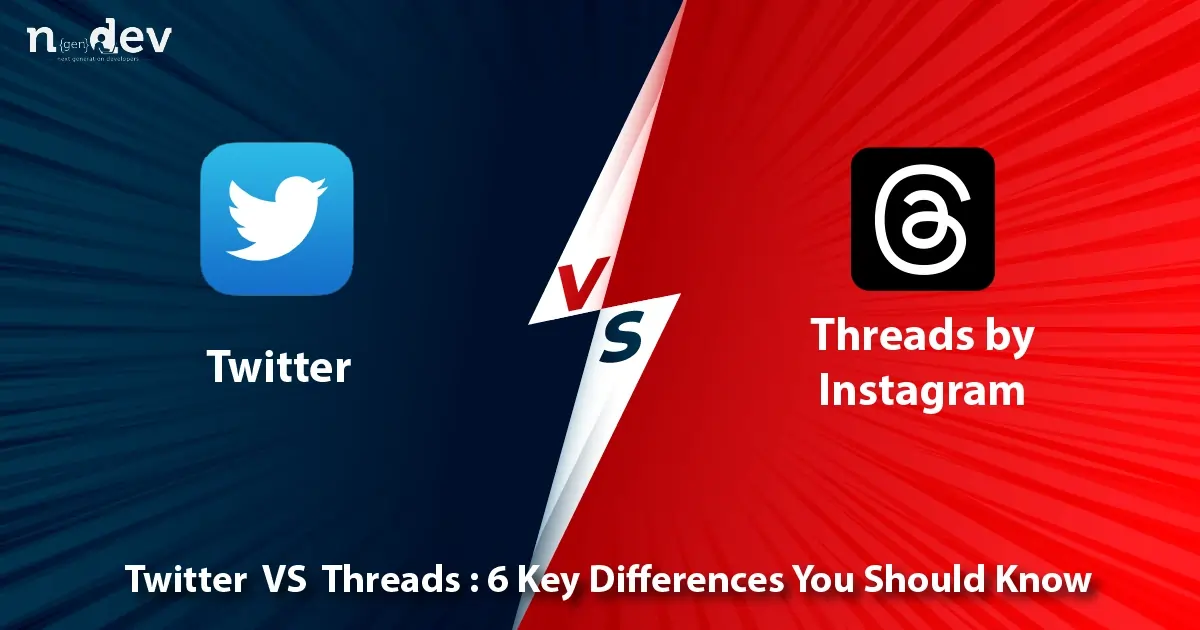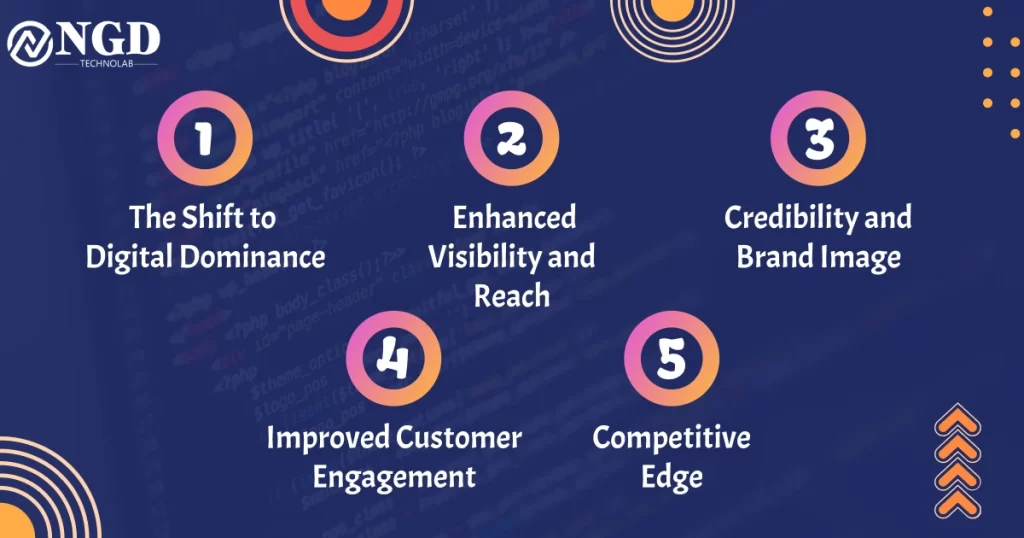Twitter vs Threads: 6 Key Differences You Should Know
-
 Prashant Padmani
Prashant Padmani

In the fast-paced world of social media, microblogging platforms have gained immense popularity. where Twitter and Threads by Meta compete for the spotlight. We explain the six key differences and uncover the essence of Twitter’s and Threds by instagram. Let’s dive into the ultimate showdown between Twitter and Thread by Instagram!
Twitter vs Thread by Instagram: A Brief Overview
Twitter and Thread by Instagram are two micro-blogging giants that have transformed how we share information and engage with others online. Both platforms offer unique features and cater to different audiences. Let’s take a closer look at what each platform brings to the table.
Twitter has no need for an introduction with its iconic 280-character tweets and real-time updates. It has become a hub for breaking news, trending topics, and viral content. Its simplicity and global reach have made it a favorite among celebrities, journalists, and individuals alike.
Thread by Instagram, a relatively newer addition to the micro-blogging scene, takes a different approach to storytelling. Instagram posts are typically visual, but Thread allows users to create a thread of posts that are based on text. Each post can have up to 500 characters. It allows users to create connected, sequential posts, weaving a narrative that goes beyond the limits of a single tweet. This format has been well-received by content creators and those seeking more in-depth interactions.
Features Comparison
When choose a micro-blogging platform, understand the features they offer is crucial. Let’s compare Twitter and Thread by Instagram to see how they stack up against each other.
Twitter boasts a straightforward user interface, where short, snappy tweets take center stage. Its streamlined design allows users to quickly scroll through their timeline and engage with content effortlessly.
On the other hand, Thread by Instagram provides a visually appealing experience, with a focus on storytelling through connected posts. Users can swipe through threads, immersing themselves in a narrative-driven format.
The 280-character limit on Twitter demands concise, impactful messages. This forces users to get creative with their content and keep it succinct.
Conversely, Thread by Instagram allows for longer posts, enabling more in-depth discussions and storytelling. Users can include multiple images, videos, and captions in each thread.
Hashtags are essential for content discovery on both platforms. Twitter popularized hashtags, making them a key component of content categorization and trend tracking.
Thread by Instagram also employs hashtags, but they play a more supplementary role, as the platform relies on the connections between posts to enhance discoverability.
User Engagement and Reach
Twitter’s real-time nature fosters instant engagement, with retweets, likes, and replies serving as primary forms of interaction. The platform’s extensive user base allows content to reach a broader audience quickly, especially when content goes viral.
Thread by Instagram leverages Instagram’s massive user base to reach a wide audience. Its visual storytelling format encourages users to spend more time engaging with content, increasing the potential for meaningful interactions and extended exposure.
Both platforms offer cross-platform integration, allowing users to share tweets and threads on other social media platforms, expanding their reach even further.
Community Building and Interaction
Twitter excels in community building, with users connecting through hashtags, Twitter chats, and retweet-based interactions. It’s an ideal platform for fostering niche communities and discussions around specific topics.
Thread by Instagram enables content creators to build engaging narratives, encouraging followers to interact through comments, likes, and direct messages. This format strengthens community ties and encourages conversation.
Influencers play a significant role on both platforms, with Twitter influencers gaining prominence through tweet engagements and retweets, while Instagram influencers thrive on visual content and storytelling through threads.
Marketing and Brand Promotion
Twitter offers various marketing opportunities, including sponsored tweets, promoted trends, and Twitter ads, helping brands reach a broader audience and boost engagement.
Thread by Instagram provides brands with a unique way to tell compelling stories and engage followers on a deeper level, enhancing brand loyalty and authenticity.
Privacy and Security
Twitter has stringent privacy policies and user controls, ensuring data protection and enabling users to manage their accounts securely.
Thread by Instagram operates under the same privacy and security infrastructure as Instagram, providing users with a reliable and trusted experience.
Pros and Cons
Twitter’s real-time updates and brevity make it perfect for instant interactions, but it can also be challenging to convey complex ideas within the character limit.
Thread by Instagram’s storytelling format allows for richer content but may not suit those seeking quick, bite-sized interactions.
Conclusion:
Twitter and Thread by Instagram have established themselves as prominent players in the micro-blogging landscape, each catering to distinct content styles and user preferences. Twitter’s real-time updates and brevity make it a go-to platform for instant interactions, while Thread by Instagram’s visual storytelling format offers a unique and engaging experience for content creators and audiences alike.
When deciding between the two platforms, consider your content strategy, objectives, and target audience. Leveraging the strengths of both Twitter and Thread by Instagram and adopting cross-promotion techniques can enhance your online presence and enable you to connect with a broader audience. Embrace the opportunities these micro-blogging platforms offer and make your mark in the dynamic world of social media.
Frequently Asked Questions:
Both Twitter and Thread by Instagram offer unique advantages for brand promotion. Twitter’s real-time engagement and diverse audience can boost brand visibility, while Thread by Instagram’s immersive storytelling can create a deeper connection with followers. Consider your brand’s goals and target audience to determine the best fit.
Yes, utilizing both platforms for cross-platform marketing can enhance your reach and engagement. Share tweets and threads on other social media channels to maximize exposure and drive traffic to your content.
Unlike Twitter’s 280-character limit, Thread by Instagram allows Each post can have up to 500 characters. Users can create connected posts with captions, images, and videos, enabling more in-depth discussions.
Engagement metrics can vary based on content, target audience, and marketing strategy. Twitter’s real-time nature fosters quick interactions, while Thread by Instagram’s narrative-driven format encourages users to spend more time engaging with content.
Get Free consultation and let us know about your custom web and Mobile App project idea

Over 13+ years of work experience, we have built 210+ web and mobile apps
We can help you with
- Dedicated Developer
- delivering high-quality development
- Custom Mobile App Development
- Innovative Solution For Startups and Enterprise

Technology reshaped e-commerce consumers experience in India: Havas Media’s whitepaper
A recent report, ‘Shaping Consumer Experiences,’ a collaborative effort by Havas Media, YouGov, and NFX across ten key markets, delves deep into the heart of India’s e-commerce
Read More
How Does Google Pay Make Money: GPay Revenue Model
In today’s digital age, mobile payment platforms have revolutionized the way we handle our finances. Google Pay, a prominent player in this arena, offers a seamless and convenient way
Read More
UPI Payments: Shaping the Future of the FinTech Industry
The world of finance is undergoing a seismic shift, and at the heart of this transformation lies the ubiquitous Unified Payments Interface (UPI). As the financial technology (FinTech) industry
Read MoreLatest Blogs
Explore the Latest Blogs on Trends and Technology.

